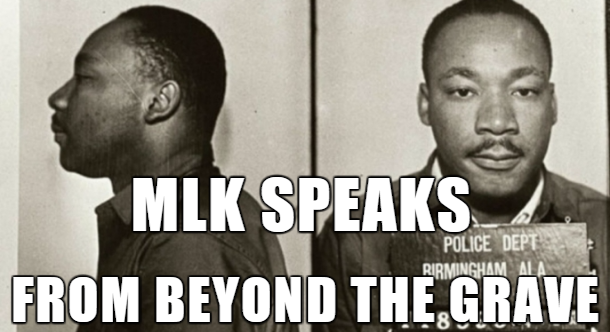
Rather than writing a diatribe about Martin Luther King Jr.’s importance today, I’ve decided to simply let him speak for himself, something rarely done in the mainstream press, despite their otherwise endless adulation.
That’s the way it is with heroes. Societies rarely ever abandon them completely, but they ignore the inconvenient messages they deliver. There are streets in every city that bare his name, but few words are ever spared for his populist, anti-war and anti-establishment message. Something I hope to rectify just a little bit here.
Paraphrased from an article in Christian Century, dated January 1957, King writes:
“Peace is not merely the absence of war, but the presence of justice.”
In King’s writings, he notes that we live in what he called a “negative peace,” where for the most part, there is an absence of conflict and physical violence, but also an absence of justice. King continues, laying out his philosophy of non-violence as a method to achieve justice.
“[Nonviolent resistance] is a method that challenges all people struggling for justice and freedom. God grant that we wage the struggle with dignity and discipline. May all who suffer oppression in this world reject the self-defeating method of retaliatory violence and choose the method that seeks to redeem. Through using this method wisely and courageously we will emerge from the bleak and desolate midnight of man’s inhumanity to man into the bright daybreak of freedom and justice.”
King notes the method of non-violent resistance can work in a number of different situations, even ones in which the oppressor is totalitarian and does not respect the rule of law. King wrote about his experiences after visiting India in 1959:
“[The Indians] praised our experiment with the non-violent resistance technique at Montgomery. They seem to look upon it as an outstanding example of the possibilities of its use in western civilization. To them as to me it also suggests that non-violent resistance when planned and positive in action can work effectively even under totalitarian regimes.”
He writes that the goal is to persuade rather than to forcibly take. King’s critics who support violent uprising said, “Nonviolence is a very potent weapon when the opponent is civilized, but nonviolence is no match or repellent for a sadist.”
King replied that yes, the power centers around the world will resist, but non-violence should be employed not simply because it is morally just, but also because it is far more effective. In an article condemning the urge for blacks to arm themselves, King wrote that enemies of change would prefer to deal with violent opponents they can crush, but a sustained peaceful protest that doesn’t go away, that stays and insists on being heard, is far more dangerous to existing power structures.
“There is more power in socially organized masses on the march than there is in guns in the hands of a few desperate men. Our enemies would prefer to deal with a small armed group rather than with a huge, unarmed but resolute mass of people. However, it is necessary that the mass-action method be persistent and unyielding.
Gandhi said the Indian people must “never let them rest,” referring to the British. He urged them to keep protesting daily and weekly, in a variety of ways. This method inspired and organized the Indian masses and disorganized and demobilized the British. It educates its myriad participants, socially and morally. All history teaches us that like a turbulent ocean beating great cliffs into fragments of rock, the determined movement of people incessantly demanding their rights always disintegrates the old order.”
In addition, King notes that if we seek peace, we must act peacefully. Likewise if we seek justice, we must act justly. However, King never says that there will be an immediate positive response. He recognizes that change is slow.
“When the underprivileged demand freedom, the privileged first react with bitterness and resistance. Even when the demands are couched in nonviolent terms, the initial response is the same.”
King is absolutely right here. When freedom fighters resist oppression in nonviolent ways, the reaction from the powerful is predictable. They argue that the protesters are upsetting society at a fragile time, that patience is necessary, that they have upset the various illusions of equality which seemed to keep the peace so well, but King reminds us that we are merely preserving a negative peace with our silence, that by forcing an uncomfortable crucible we can actually begin to solve the problems harming the country.
In a 1961 article titled, “Love, Law and Civil Disobediance,” he wrote:
“I think this is what Jesus meant when he looked at his disciples one day and said, ‘I come not to bring peace but a sword.’ Now certainly he didn’t mean he came to bring a physical sword. Certainly he didn’t mean that he did not come to bring true peace. But Jesus was saying in substance… whenever I come, a conflict is precipitated between the old and the new. Whenever I come, tension sets in between justice and injustice… I come not to bring a negative peace, but a positive peace, which is brotherhood, which is justice, which is the kingdom of God.”
The nonviolent demonstrator is the primary tool for this crucible, by accepting to take on pain, he forces the truth into the open. These protests can be sustained for long periods of time and may cause great inconveniences.
“[The nonviolent demonstrator] sees the misery of his people so clearly that he volunteers to suffer in their behalf and put an end to their plight… when marching is seen as a part of a program to dramatize an evil, to mobilize the forces of good will, and to generate pressure and power for change, marches will continue to be effective.
Our experience is that marches must continue over a period of thirty to forty-five days to produce any meaningful results. They must also be of sufficient size to produce some inconvenience to the forces in power or they go unnoticed. In other words, they must demand the attention of the press, for it is the press which interprets the issue to the community at large and thereby sets in motion the machinery for change.”
Just before King was assassinated in 1968, he wrote an article titled, “Showdown for Nonviolence” where he insisted that lengthy campaigns produced results in ways that shorter marches could not. These lengthy protests were beneficial in a number of different ways. Crime rates dropped and it brought people together in a practical cause.
He also notes, that unless change comes quickly, the nation will face a summer of rage.
“We are taking action after sober reflection. We have learned from bitter experience that our government does not correct a race problem until it is confronted directly and dramatically. We also know as official Washington may not, that the flash point of Negro rage is close at hand. Our Washington demonstration… will be more than a one day protest — it can persist for two or three months.
Just as we dealt with the social problem of segregation through massive demonstrations, and we dealt with the political problem — the denial of the right to vote — through massive demonstrations, we are now trying to deal with the economic problems — the right to live, to have a job and income — through massive protests… a program that would really deal with jobs could minimize — I don’t say stop — the number of riots that could take place this summer.”
If we fail and the government refuses to acknowledge the issues?
“I am convinced that if rioting continues, it will strengthen the right wing of this country and we’ll end up with a kind of right wing takeover in the cities and fascist development, which will be injurious to the whole nation… In any event, we will not be the ones who will have failed. We will place the problems of the poor at the seat of government of the wealthiest nation in the history of mankind. If that power refuses to acknowledge its debt to the poor, it will have failed to live up to its promise to ensure “life, liberty and the pursuit of happiness” to its citizens…
We have, through massive nonviolent action, an opportunity to avoid a national disaster and create a new spirit of class and racial harmony. We can write another luminous moral chapter in American history. All of us are on trial in this troubled hour, but time still permits us to meet the future with a clear conscience.”

If you enjoyed this content, please donate. Even $1 or $5 makes a difference. You can donate via Paypal (see tip jar to the right) or with

